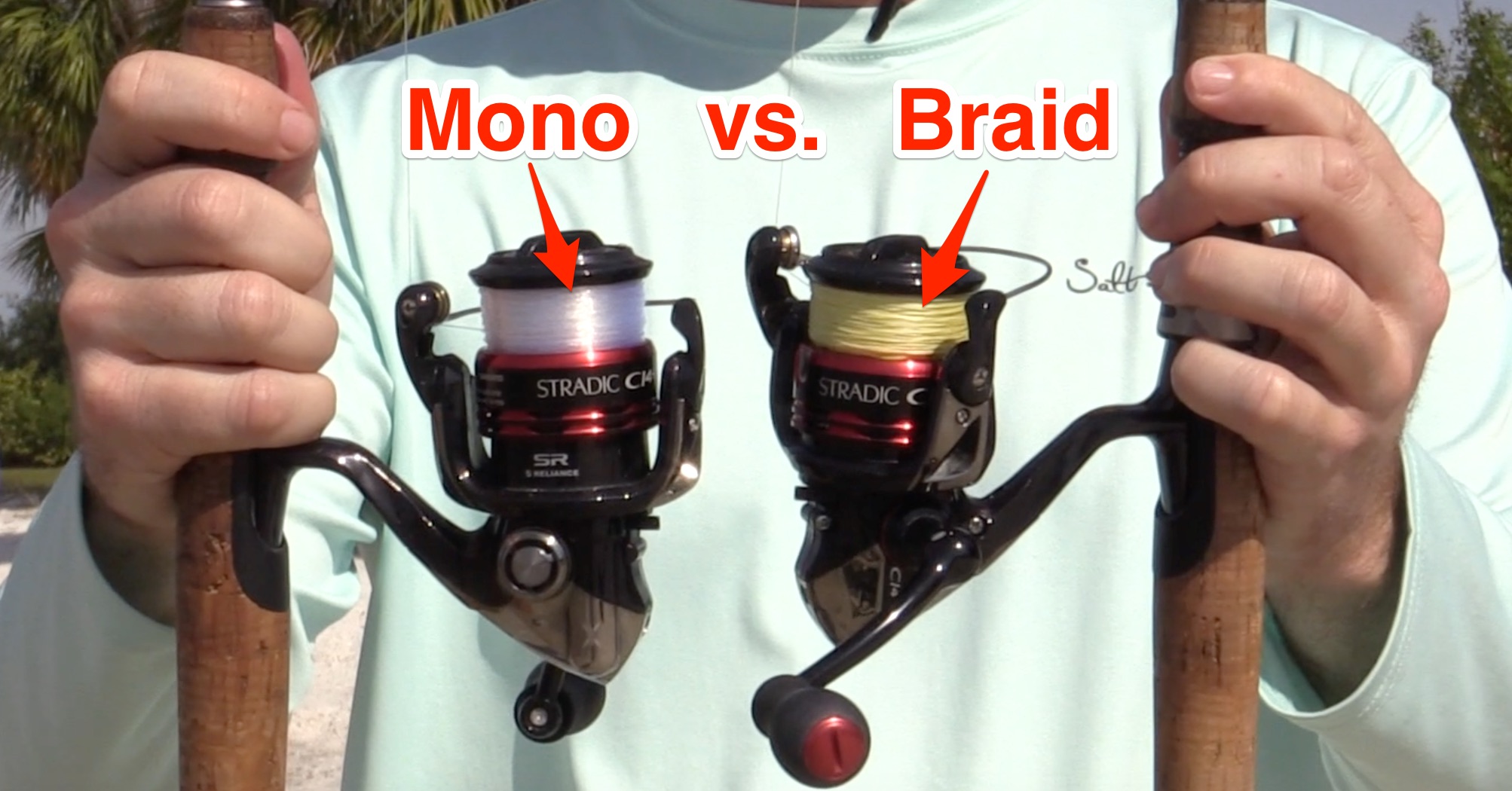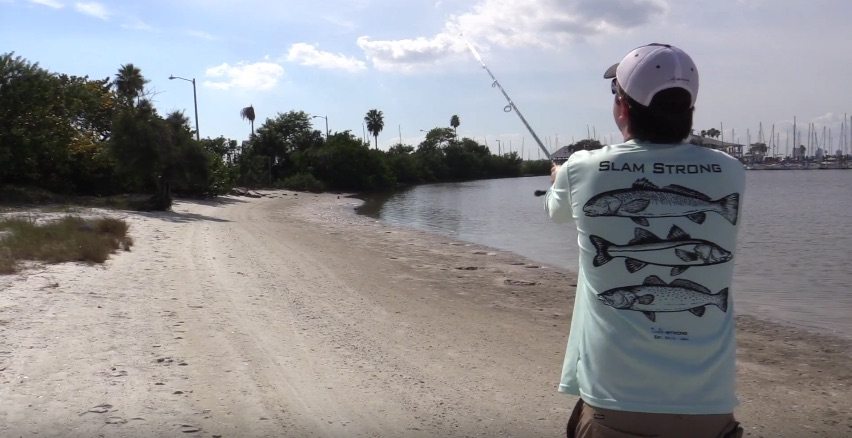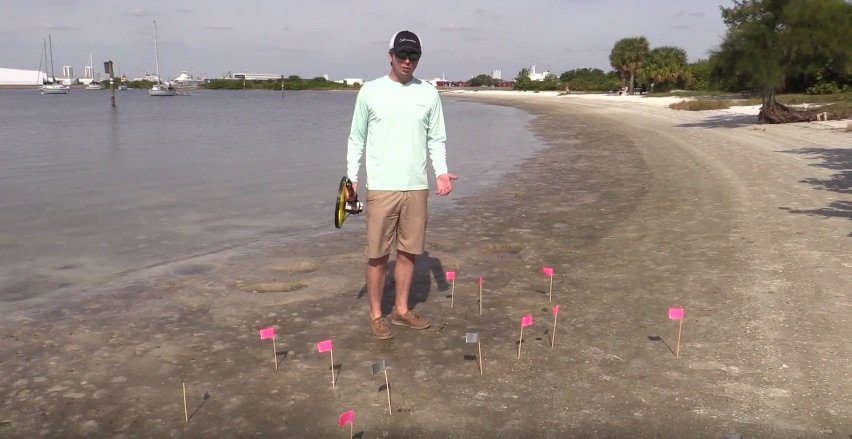Braid vs. Mono Casting Distance Experiment [Both Light & Heavy Lures]
- By: Luke Simonds
- on

What do you think casts further…
Braid or mono?
And how much further does the winner cast?
Many anglers have asked about the difference between braid and mono in terms of casting, so I thought that I’d host an experiment to have an educated answer to that question.
Before performing this casting experiment, I had no idea how much further I could actually cast with braid compared to mono on my spin casting gear.
I could see that my casts increased once I finally switched over the braid, but I was not sure if the increase was 5%, 10%, 20% or perhaps even more.
[Update]
After seeing some great questions from the community, I performed an added experiment to cover the following two variables:
- Lighter lure (the first test was a 1/2 oz weight that was an absolute bullet)
- Wet lines (this Updated test was over the water so that the lines were both wet at all times)
Braid vs. Mono Casting Experiment

My theory has always been that we should always try to use the lightest line that can handle our target species so that we can maximize our casting and retrieving performance.
So I put the focus strictly on the rated power of the lines since the power needed to catch a target fish is the driving force when deciding which power level of fishing line is needed.
Since I most often use 10 lb braid line when fishing for redfish, snook, trout, bass, etc., I decided to load a reel up with a 10 lb monofilament line to use for the test.
Here are the variables that are in this experiment:
- Line Power: Equal – both at 10 lbs
- Rod Lenght: Equal – both the exact same 7’6″ rods made by the same manufacturer with the same power rating
- Reels: Equal – both lines were on the same sized Shimano Stradic Ci4 reel
- Lures: Equal – both were 1/2 oz teardrop shaped weights so that wind-friction is minimized
- Casting Force – As equal as possible without a $$$$ machine
- Line Diameter: Not equal – but that’s ok because it is part of the reason why braid has an advantage
Note: I did 5 casts with each line for the first round before switching the weights and doing 5 more casts to make sure that the weights used were not impacting the results.
Click on the video below to see the full braid vs mono experiment:
Note: This first test analyzes the difference of braid vs. mono when casting a heavy/aerodynamic lure… the updated test below this first video shows the differences when casting a lighter lure.
[Updated Experiment]
After seeing some great questions from the community, I performed another test to see how different the results would be if:
- The weight/lure was lighter (3/16th oz vs. 1/2 oz)
- The lines were wet
Note: If you want to get the absolute most distance on your casts, try out our new Casting Mastery course which guarantees you’ll get an extra 10 ft or more on every cast after completing the online course.
Braid vs. Mono Casting Test Results
As expected, the braid enabled me to have longer casting distance relative to the same power line in mono.
But the surprise was that the difference was closer than I expected (just ~7%) for the heavier lures… my assumption was that the braid would get at least an extra 10% or more extra distance.
However, my theory was proven right in the 2nd test when I used a lighter weight to resemble a lighter lure (this test used a 3/16th oz weight to represent a lighter lure). In this updated test, the difference was a whopping 30% in favor of the braid.
Note: These results will vary depending on the exact lines that are being used as well as the amount of line that is loaded on the reel.
Also, the 2nd test was using a new spool of braid compared to the first test which had a used spool of braid.
Here are the lines I used in this test:
- Braid – 10 lb PowerPro
- Mono – 10 lb Berkley Trilene XL
For the lure, I used a weight so that it would represent the weight of a lure without having varying wind-drag differences that would alter the results.
The original test had a 1/2 oz weight, and the 2nd test had a 3/16th oz weight.
Conclusion

Braid proved to be the better choice compared to traditional monofilament line in terms of casting distance for both experiments.
The first test with a heavier weight showed a 7% advantage to the braid.
And the updated test with wet lines that were both newly spooled showed a whopping 30% advantage for the braid.
Although the 7% doesn’t seem like a big deal at first glance, it still equates to an extra football field of water coverage every 43 casts.
And at the 30% advantage when using lighter lures, that’s an extra football field every 10 casts… WOW!
Given the statistical fact that more water covered = more fish caught, it’s essential for us to do all that we can in order to maximize our casting distance if we want to maximize our fish-catching results.
And it seems evident that those of us who do a lot of casting with spinning reels need to highly consider using braid so that we can maximize our results.
Want to Supercharge Your Casting Distance in just 30 minutes?
Register for our new Casting Mastery course right now because it guarantees that you’ll get an extra 10 ft of distance on every cast as soon as you complete this great online course…
It’s a structured video-based course that can be completed in just 30 minutes, and you’ll get a full refund if you’re not 100% satisfied with your investment.
Click here to learn more about the Casting Mastery course.
Leave a comment below if you have any questions.
P.S. – Be sure to send this article to any of your fishing friends who are still using monofilament line on their spinning gear because it can get them an extra 7% longer casts by making just one simple switch.
Related Posts:
– This Is What Can Happen When Sight Fishing From A 3rd-Floor Balcony
Fish On!
See More Fishing Line Tests/Reviews
Related categories:
STOP WASTING TIME ON THE WATER!
Do what the “SMART ANGLERS” are doing and join the Insider Club.
Here’s what you’ll receive today when you join:
- Weekly fishing reports and TRENDS revealing exactly where you should fish every trip
- Weekly “spot dissection” videos that walk you through all the best spots in your area
- Exclusive fishing tips from the PROS you can’t find anywhere else
- Everything you need to start catching fish more consistently (regardless if you fish out of a boat, kayak, or land).









Thanks for the great test
If you want abrasion resistance and distance, would be interesting how mono only compares with mono leader and braid mainline. Less resistance of braid but with leader knot having to pass through runners.
The mono will be the victor for an abrasion only focus. But the advantages of braid for feeling strikes and getting good hooksets is well worth the risk since the first 2 ft of line is what most often takes the brunt of abrasion impact… the mono leader with a braid mainline is tough to beat.
Great test, thanks. How much does the knot impact casting distance? As Rod mentioned, a straight mono line might cast farther than braid with a mono leader since you wouldn’t have the knot slowing your cast down through the guides. In some applications, straight mono without a leader would work fine.
Also, would love a test using braid with no leader at all. I’m guessing it would make very little difference, because probably we overhype fishing getting spooked by line (yes, I understand there are certain applications where a special leader is needed).
I typically use a leader line that’s short enough to enable casting without it going through the guides (20 to 30 inches), so that knot isn’t an issue.
Thanks Luke.This helps greatly with my personal recent debate of whether I should keep using braid or just stick with the mono. Love the comparisons that you do so keep em coming.We will all have our personal opinions, but I am about as amateur as it comes, especially in saltwater, and have learned a ton in the short time I have been a member. I will suck in all of the advice and weed it out later. LOL
I’m glad to see that you enjoyed this video. Although braid will take a bit to get used to, it’s far superior when used properly so I am sure you’ll be glad you made the switch like I was when I finally gave it a shot.
Just because your casting farther doesn’t mean your covering more water equaling more fish caught. The guy casting shorter distance will be making more cast if your both retrieving at the same speed because it’ll take you longer to retrieve the bait. Granted the time taken to make a few more cast vs yours takes a little time but its very little per hour. The real benefit is reaching far targets if your bank fishing
I completely agree with the premise about the fact that if two people are retrieving lures at the same rate and are taking the same time to cast, the amount of water covered in a given time is going to be very close (longer cast will win based on the slightly less time the lure is out of the water relative to the shorter caster).
In my opinion, the biggest benefit of extra distance is more about the added time the long caster has in the strike zone compared to the short caster. When fishing the shallows from a boat, the fish can be very spooky so the 30 ft and shorter distance is pretty much going to be a dead zone. And the farther away from the boat the lure goes, the more likely the fish that see it have no idea that danger is in the area, so they’re more likely to strike. And the long caster gets to cover that ideal strike zone while also having much more time away from the 30 ft dead zone.
Great article/video and comparison! Curious to know how these newer copolymer lines stack up against braid too. Or has anyone tried and does braid still outcast even the copolymer/hybrid lines?
If it has memory and a thicker diameter, it’ll most likely not be able to compete with braid. I’ll make sure to do some more tests this year and will include some hybrids.
I recently tried Ardent Gliss line as it was praised for its casting distance. I must say this line out casts everything I have used thus far. I don’t think it will hold up to abrasion very well. I plan on using a long top sot of mono to compensate for its thin diameter. I also don’t think it will last as long as braid. I think it will have to be changed out regularly to maintain its strength. This line is reasonably priced and only the top 150 yards probably need to changed to regularly. I gained probably about 20 yards of distance on my surf rod using Gliss. Having this advantage will come at a cost no doubt. It is still less expensive than using Flourocarbon leaders on all your rigs throughout the year. At least the actual distance of using Gliss can actually be seen.
Thanks for sharing your results with Gliss! I’ll be sure to keep an eye out for it on my next shopping spree.
Wonder how much difference it makes if you have 20 lb fluorocarbon leaders on them
The leaders shouldn’t make much of a difference because they are not causing much wind drag since they are lined up directly behind the lure and go straight back… so the only drag is the knot which is minimal (especially if using the very thin FG knot: https://saltstrongdev.wpengine.com/articles/fg-knot/).
Thanks for your response. One of the biggest problems I have because I have so many rods and reels, is I never remember what size lines I have on my reels. Do you have any system that you use to keep track of that
My system is to simply put 10 lb braid on all of my 2500 and 3000 sized reels (the ones I use the most). I then I have 20 lb on my 4000 series reel that I use if fishing for big fish in heavy current or around a lot of structure. And then I have 30 lb on my bigger reels for tarpon and grouper fishing.
Sounds good to me, thank again!!
FG knot is king!
RE: “Casting Mastery Course” do you include bait casters in this course? I just bought an Abu-Garcia Silver Max loaded with 10 lb. stren, (my 1st casting reel in 50 yrs.) with a Field & Stream 6’9″ med. rod but can’t seem to get more than 15ft. ?
The Casting Course is focused on Spinning Tackle right now, but it does have a bonus section for bait casters. I’ll be adding a bait casting section next chance I get.
what about throwing in some fluoro to compare to the other 2?
As a long time rod builder the experiment that I would be interested in seeing would be how guide diameter effects casting distance with both types of line. Many rod manufacturers have been downsizing the diameter of their guides as part of an aesthetic trend. I have noticed that although this can in a few cases slightly increase casting distance w braid , it can really hinder the distance with mono or flouro on spinning rods. Casting rods are a completely different story as the line leaves the reel in a much straighter line. When I build spinning rods for guys that need to use mono, I run old school bigger guides and less of them. This seems to create less resistance as the funnel of line from the reel is tightened in smaller increments, allowing for the larger diameter, stiffness and memory of mono. Most of my experience with this is in lighter test lines with light weight rigs. (Line 6-15, lure .25 -1.5 oz) But, I have never actually built 2 identical blanks w different guides and done the same casting test w mono and braid.
That would be a great test. I’m curious to know how much of a difference the smaller guides make.